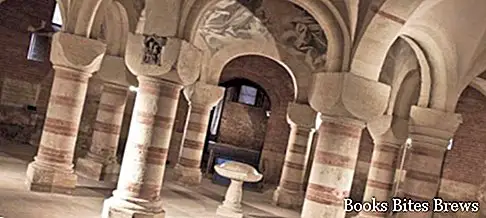What to see in Asti, itinerary including the main monuments and places of interest including the Crypt of Sant'Anastasio, the Cathedral of Santa Maria Assunta, the Red Tower and Palazzo Alfieri.
Tourist information
Located on the left bank of the Tanaro river, between the Borbore and Valmanera streams, Asti is a town in Monferrato, very renowned for the production of wines and sparkling wines.
In the past it was a Ligurian settlement and a Roman town hall, later it became a Lombard duchy.
After being destroyed by Barbarossa in 1155, it found itself at the center of some disputes, in which the Marquis of Monferrato, Amedeo V of Savoy, Roberto d'Angiò and the Visconti ended up prevailing respectively, until the annexation to the Kingdom of Sardinia, which took place in the late 1700s.
The urban aspect of the historic center is of a typical medieval mold.
The Cathedral, dedicated to the Assumption and located in the square of the same name, is a good example of the Piedmontese Gothic style.
It was built in the first half of the 1300s on top of an eleventh-century building, then it underwent various alterations.
The right side is enhanced by a magnificent sixteenth-century prothyrum, expertly decorated and having high mullioned windows.
The facade has three portals splayed in an accentuated manner, while at the bottom stands the monumental bell tower from 1266.
The interior with three naves supported by tall columns resembles models of the French Gothic style, despite the presence of a frescoed decoration from the 1700s.
There are also altarpieces from the fifteenth and sixteenth centuries, including some by Gandolfino d’Asti, as well as a priceless treasure.
Recommended readings- Alessandria (Piedmont): what to see in 1 day
- Langhe (Piedmont): what to see among castles, villages and vines
- Piedmont: Sunday day trips
- Oropa (Piedmont): what to see
- Cherasco (Piedmont): what to see
The Crypt of San Giovanni is very interesting, located under the church of the same name and dating back to the eighth century.
The Roman tower, also known as the Red Tower of San Secondo and located in Corso Alfieri, was erected during the period when Emperor Augustus was, as part of the city walls, of which it is the best testimony.
The tower is composed of a square base, on which sixteen sides open by windows rest, and of a cylindrical upper part added during the Middle Ages.
On the same road axis overlooks the eighteenth-century Palazzo Alfieri, the birthplace of Vittorio Alfieri in 1749, where the national center of Alfieran studies and a museum that preserves some memories of the poet are located.
Continuing to walk, you come across the classical high school Vittorio Alfieri, in whose basement there is the Crypt of Sant'Anastasio, containing a lapidary collection and architectural remains.
What see
Still on Corso Alfieri is the Palazzo di Bellino, almost entirely redone by Benedetto Alfieri, where the Risorgimento museum and the civic art gallery are housed, which include important artistic testimonies of the past.
On the opposite side stands the Torre del Comentini, construction of 1200.
The Church of San Secondo, located in the square of the same name, was built between the thirteenth and fifteenth centuries, above the remains of an earlier building.
Completely restored afterwards, today only the bell tower remains, as evidence of the old church.
The tripartite facade opens abundantly decorated portals, while the right side is enlivened by chapels and a Romanesque triburio.
Inside there are the crypt, the Chapel of San Secondo and the remains of frescoes from the 1400s.
The Troyana Tower, located in Piazza Medici and also known as the Clock Tower, is part of the Troya Palace.
Once you cross Piazza Alfieri, you reach the Santa Maria Nuova church, equipped with a Romanesque bell tower.
The Baptistery of San Pietro, also known as Rotonda, constitutes the largest city monument from the Middle Ages.
Built in 1200, it has an octagonal plan and a central lantern.
Inside there is a round of low columns surmounted by arches on which the dome rests.
Connected to the baptistery is the Church of San Pietro in Consavia, built in the first half of the fifteenth century with a quadrilateral plan and refined terracotta decorations on the windows and cornices.
Nearby is the Archaeological Museum, housed in the building that once served as the ancient pilgrims' hospital.
It contains Roman finds, objects from the early medieval period, various works of painting and sculpture, as well as remains of prehistoric animals.




